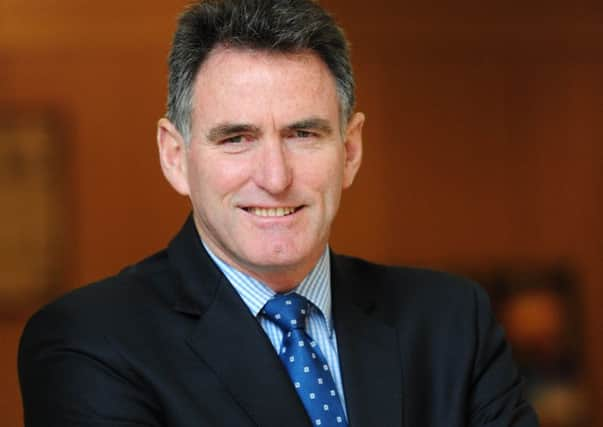Martin Flanagan: RBS remains under a cloud as Lloyds eyes sunlit uplands


The financial figures for 2016 and joint outlooks will be a further compare-and-contrast opportunity. RBS, now under the stewardship of Ross McEwan, is still mired in a British mid-winter of heavy losses via a vortex of legacy issues and fines. Lloyds, led by Antonio Horta-Osorio, is enjoying the continuing springtime of the lender’s return to investor respectability, with an eye-catching jump in profits. As the pop song doesn’t quite have it, wherever these two banks go, they always take the weather with them.
Lloyds started from a better place. The size of its state-constructed oxygen tent was £20 billion, less than half the £45bn thrown to RBS.
Advertisement
Hide AdAdvertisement
Hide AdAt the nadir, the Treasury held more than 80 per cent of RBS compared with just over 40 per cent of Lloyds, which also owns Scottish Widows and Bank of Scotland. As a result, it has been a more tortuous road back towards normality for RBS.
While not overlooking a deeply flawed, systems and controls-lite HBOS, there was also far less for new management at Lloyds to do overall than at its rival. RBS had a labyrinthine international and business-stream structure constructed by former boss Fred Goodwin, where flag-planting became a fetish. By contrast, Lloyds, under its American-born former chief executive Eric Daniels, had largely kept the bank on the UK-domestic straight and narrow.
In fact, it was to expand its hegemony on these shores that Lloyds was unfortunately tempted to acquire HBOS, giving it an even bigger market-leading stranglehold on UK current accounts and mortgages. In card-playing parlance, strategically the group decided to twist rather than stick, and came unstuck.
But as its earnings recovery has taken hold, Lloyds has steadily cut the taxpayer stake so that now it is pretty nominal at under 5 per cent. More than £18.5bn of the bailout has been returned to the Treasury’s coffers, a financial and public relations boon.
By contrast, RBS, even though selling some shares at a loss to the £5 taxpayer buy-in price, still has the government speaking for more than 70 per cent of its stock. The shares closed on Friday at 242p and it will likely be at least in the 2020s before the bank is totally independent of Whitehall again. This week’s red ink will underline that truth.
RBS, which reports on Friday, is expected to unveil its ninth successive year of losses. Perhaps the only good aspect is that the estimated loss of about £6bn for 2016 is dwarfed by the £24bn loss in 2008, the year of the financial crash. Once again, this is partly due to another of the many “bumps in the road” to recovery glumly foreshadowed by McEwan, arising from fines for legacy issues.
Overall, the group has notched up losses of more than £50bn since the crisis. The bank is taking another $3.8bn (£3.1bn) provision for Q4 of last year for mis-selling opaque and toxic mortgage-backed bonds in the lead-up to the crash. It takes the bank’s total provisions on the issue to $8.3bn, and it has served notice that “further substantial additional provisions and costs may be recognised”. Plus ça change...
However, losses at RBS are now seen as curiously complementary as bacon and eggs. The City spotlight will segue from the bald trading figures to other underlying issues before you can say “net interest margin” because factored-in mega-losses are unexciting. These other challenges include the bank’s failure to pass the most recent Bank of England financial stress tests – and the continuing management plans as a result to strengthen its balance sheet – and the interminable saga of the lender’s failure to sell or float off its Williams & Glyn branches, which it had been ordered to do by the European Union to address competition concerns. On Friday the government said RBS could abandon the sale entirely and instead provide £750 million of initiatives to boost competition in UK business banking. This, McEwan said, would deal with the EU obligations “more quickly and with more certainty than undertaking a difficult and complex sale”.
Advertisement
Hide AdAdvertisement
Hide AdMcEwan will also be quizzed on reports that the bank is looking to take another £1bn or so off its cost base, partly to address lower for longer interest rates, and that it could involve many thousands more job losses from a headcount that, as at Lloyds, has been decimated in the aftermath of the financial crisis. Hardly Cassandra-like, I admit, but I expect McEwan to confirm the cost-cutting direction of travel but with a coyness on actual figures. Unfortunate, really, but like the phalanx of big banks on rationalisation details, he is damned if he does, damned if he doesn’t.
Many think Horta-Osorio is edging towards the exit at Lloyds before this year is out after an eventful but ultimately fruit-bearing six years of turning around the Black Horse bank that bolted. He will have much justification for that greater spring in his step. The City consensus is for 2016 profits of £4.4bn – a sharp jump on the £1.64bn profit in the previous year, despite added provisions for payment protection insurance, it being the bank with the biggest ongoing exposure to the scandal. As with all the other banking majors, also expect Lloyds to talk more about the inevitability of branch closures in the face of digitalisation eating the industry.
Some investors harbour hopes for a special dividend as well as a final payout to reflect Lloyds’s operational rejuvenation and rehabilitation with shareholders. A special divi, either this week or at the next interim results this summer, would also have a valedictory panache if Horta-Osorio does decide to ride into a Portuguese sunset.